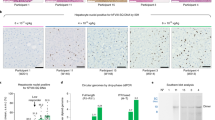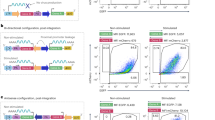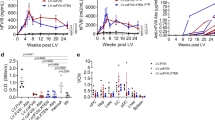Abstract
Effective gene therapy for haemophilia A necessitates a vector system that is not subject to a pre-existing immune response, has adequate coding capacity, gives long-term expression and preferably can target non-dividing cells. Vector systems based on lentiviruses such as equine infectious anaemia virus (EIAV) fulfil these criteria for the delivery of factor VIII (FVIII). We have found that B domain-deleted (BDD) FVIII protein inhibits functional viral particle production when co-expressed with the EIAV vector system. Although particle numbers (as measured by reverse transcriptase activity) are near normal, RNA genome levels are reduced and measurement of integrated copies revealed the virus is severely defective in its ability to transduce target cells. This is due to the absence of sufficient vesicular stomatitis virus glycoprotein (VSV-G) envelope on viral particles derived from cells expressing FVIII. By using an internal tissue-specific promoter, that has low activity in the producer cells, to drive expression of FVIII we have overcome this inhibitory effect allowing us to generate titres approaching those obtained with vector genomes encoding reporter genes. Furthermore, we report that codon optimization of the full-length FVIII gene increased vector titres approximately 10-fold in addition to substantially improving expression per integrated vector copy.
This is a preview of subscription content, access via your institution
Access options
Subscribe to this journal
Receive 12 print issues and online access
$259.00 per year
only $21.58 per issue
Buy this article
- Purchase on Springer Link
- Instant access to full article PDF
Prices may be subject to local taxes which are calculated during checkout







Similar content being viewed by others
References
Kaufman RJ, Wasley LC, Davies MV, Wise RJ, Israel DI, Dorner AJ . Effect of von Willebrand factor coexpression on the synthesis and secretion of factor VIII in Chinese hamster ovary cells. Mol Cell Biol 1989; 9: 1233–1242.
Koeberl DD, Halbert C, Krumm A, Miller AD . Sequences within the coding regions of clotting factor VIII and CFTR block transcriptional elongation. Hum Gene Ther 1995; 6: 469–479.
Hoeben RC, Fallaux FJ, Cramer SJ, van den Wollenberg DJ, van Ormondt H, Briet E et al. Expression of the blood-clotting factor-VIII cDNA is repressed by a transcriptional silencer located in its coding region. Blood 1995; 85: 2447–2454.
Fallaux FJ, Hoeben RC, Cramer SJ, van den Wollenberg DJ, Briet E, van Ormondt H et al. The human clotting factor VIII cDNA contains an autonomously replicating sequence consensus- and matrix attachment region-like sequence that binds a nuclear factor, represses heterologous gene expression, and mediates the transcriptional effects of sodium butyrate. Mol Cell Biol 1996; 16: 4264–4272.
Kaufman RJ, Wasley LC, Dorner AJ . Synthesis, processing, and secretion of recombinant human factor VIII expressed in mammalian cells. J Biol Chem 1988; 263: 6352–6362.
Lynch CM, Israel DI, Kaufman RJ, Miller AD . Sequences in the coding region of clotting factor VIII act as dominant inhibitors of RNA accumulation and protein production. Hum Gene Ther 1993; 4: 259–272.
Chuah MK, Vandendriessche T, Morgan RA . Development and analysis of retroviral vectors expressing human factor VIII as a potential gene therapy for hemophilia A. Hum Gene Ther 1995; 6: 1363–1377.
Dwarki VJ, Belloni P, Nijjar T, Smith J, Couto L, Rabier M et al. Gene therapy for hemophilia A: production of therapeutic levels of human factor VIII in vivo in mice. Proc Natl Acad Sci USA 1995; 92: 1023–1027.
Fallaux FJ, Hoeben RC . Gene therapy for the hemophilias. Curr Opin Hematol 1996; 3: 385–389.
Powell JS, Ragni MV, White GC, Lusher JM, Hillman-Wiseman C, Moon TE et al. Phase 1 trial of FVIII gene transfer for severe hemophilia A using a retroviral construct administered by peripheral intravenous infusion. Blood 2003; 102: 2038–2045.
Kafri T, Blomer U, Peterson DA, Gage FH, Verma IM . Sustained expression of genes delivered directly into liver and muscle by lentiviral vectors. Nat Genet 1997; 17: 314–317.
Park F, Ohashi K, Kay MA . Therapeutic levels of human factor VIII and IX using HIV-1-based lentiviral vectors in mouse liver. Blood 2000; 96: 1173–1176.
Kootstra NA, Matsumura R, Verma IM . Efficient production of human FVIII in hemophilic mice using lentiviral vectors. Mol Ther 2003; 7: 623–631.
Park F . Correction of bleeding diathesis without liver toxicity using arenaviral-pseudotyped HIV-1-based vectors in hemophilia A mice. Hum Gene Ther 2003; 14: 1489–1494.
Stein CS, Kang Y, Sauter SL, Townsend K, Staber P, Derksen TA et al. In vivo treatment of hemophilia A and mucopolysaccharidosis type VII using nonprimate lentiviral vectors. Mol Ther 2001; 3: 850–856.
Kang Y, Xie L, Tran DT, Stein CS, Hickey M, Davidson BL et al. Persistent expression of factor VIII in vivo following nonprimate lentiviral gene transfer. Blood 2005; 106: 1552–1558.
Haas J, Park E-C, Seed B . Codon usage limitation in the expression of HIV-1 envelope glycoprotein. Curr Biol 1996; 6: 315–324.
Kramer MG, Barajas M, Razquin N, Berraondo P, Rodrigo M, Wu C et al. In vitro and in vivo comparative study of chimeric liver-specific promoters. Mol Ther 2003; 7: 375–385.
Wilkes FJ, Rohll JB, Radcliffe PA, Azzouz M, Miskin JE, Ellard F et al. Manuscript in preparation. 2007.
Tonn T, Herder C, Becker S, Seifried E, Grez M . Generation and characterization of human hematopoietic cell lines expressing factor VIII. J Hematother Stem Cell Res 2002; 11: 695–704.
Farley DC, Iqball S, Smith JC, Miskin JE, Kingsman SM, Mitrophanous KA . Factors that influence VSV-G pseudotyping and transduction efficiency of lentiviral vectors-in vitro and in vivo implications. J Gene Med 2007; 9: 345–356.
Becker S, Simpson JC, Pepperkok R, Heinz S, Herder C, Grez M et al. Confocal microscopy analysis of native, full length and B-domain deleted coagulation factor VIII trafficking in mammalian cells. Thromb Haemost 2004; 92: 23–35.
Ponder KP, Dunbar RP, Wilson DR, Darlington GJ, Woo SL . Evaluation of relative promoter strength in primary hepatocytes using optimized lipofection. Hum Gene Ther 1991; 2: 41–52.
Kay MA, Baley P, Rothenberg S, Leland F, Fleming L, Ponder KP et al. Expression of human alpha 1-antitrypsin in dogs after autologous transplantation of retroviral transduced hepatocytes. Proc Natl Acad Sci USA 1992; 89: 89–93.
Follenzi A, Battaglia M, Lombardo A, Annoni A, Roncarolo MG, Naldini L . Targeting lentiviral vector expression to hepatocytes limits transgene-specific immune response and establishes long-term expression of human antihemophilic factor IX in mice. Blood 2004; 103: 3700–3709.
Oertel M, Rosencrantz R, Chen YQ, Thota PN, Sandhu JS, Dabeva MD et al. Repopulation of rat liver by fetal hepatoblasts and adult hepatocytes transduced ex vivo with lentiviral vectors. Hepatology 2003; 37: 994–1005.
Wong LF, Azzouz M, Walmsley LE, Askham Z, Wilkes FJ, Mitrophanous KA et al. Transduction patterns of pseudotyped lentiviral vectors in the nervous system. Mol Ther 2004; 9: 101–111.
Rohll JB, Mitrophanous KA, Martin-Rendon E, Ellard FM, Radcliffe PA, Mazarakis ND et al. Design, production, safety, evaluation, and clinical applications of nonprimate lentiviral vectors. Methods Enzymol 2002; 346: 466–500.
Soneoka Y, Cannon PM, Ramsdale EE, Griffiths JC, Romano G, Kingsman SM et al. A transient three-plasmid expression system for the production of high titer retroviral vectors. Nucleic Acids Res 1995; 23: 628–633.
Yee JK, Miyanohara A, LaPorte P, Bouic K, Burns JC, Friedmann T . A general method for the generation of high-titer, pantropic retroviral vectors: highly efficient infection of primary hepatocytes. Proc Natl Acad Sci USA 1994; 91: 9564–9568.
Yang ZY, Duckers HJ, Sullivan NJ, Sanchez A, Nabel EG, Nabel GJ . Identification of the Ebola virus glycoprotein as the main viral determinant of vascular cell cytotoxicity and injury. Nat Med 2000; 6: 886–889.
Sharkey CM, North CL, Kuhn RJ, Sanders DA . Ross River virus glycoprotein-pseudotyped retroviruses and stable cell lines for their production. J Virol 2001; 75: 2653–2659.
Kotsopoulou E, Kim VN, Kingsman AJ, Kingsman SM, Mitrophanous KA . A Rev-independent human immunodeficiency virus type 1 (HIV-1)-based vector that exploits a codon-optimized HIV-1 gag-pol gene. J Virol 2000; 74: 4839–4852.
Acknowledgements
We are grateful to Neil Ward for help with codon optimization of the BDD FVIII sequence. Part of this work was supported by a grant from the Department of Health for gene therapy research on single gene disorders.
Author information
Authors and Affiliations
Corresponding author
Rights and permissions
About this article
Cite this article
Radcliffe, P., Sion, C., Wilkes, F. et al. Analysis of factor VIII mediated suppression of lentiviral vector titres. Gene Ther 15, 289–297 (2008). https://doi.org/10.1038/sj.gt.3303080
Received:
Revised:
Accepted:
Published:
Issue Date:
DOI: https://doi.org/10.1038/sj.gt.3303080
Keywords
This article is cited by
-
Enhancing titres of therapeutic viral vectors using the transgene repression in vector production (TRiP) system
Nature Communications (2017)
-
High-throughput screening identifies compounds that enhance lentiviral transduction
Gene Therapy (2014)
-
Production, concentration and titration of pseudotyped HIV-1-based lentiviral vectors
Nature Protocols (2009)
-
Transgene optimization significantly improves SIN vector titers, gp91phox expression and reconstitution of superoxide production in X-CGD cells
Gene Therapy (2009)
-
Development of inducible EIAV-based lentiviral vector packaging and producer cell lines
Gene Therapy (2009)



